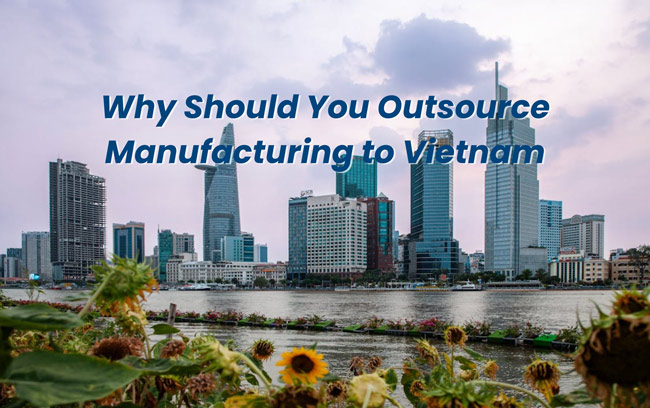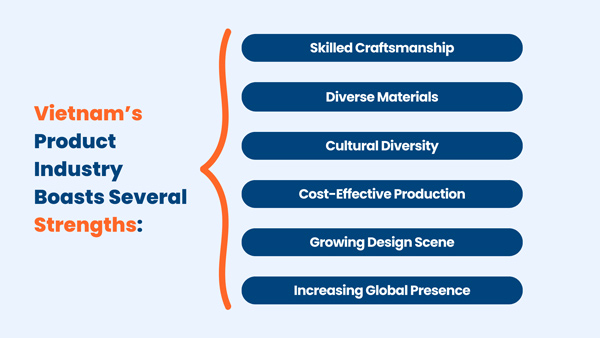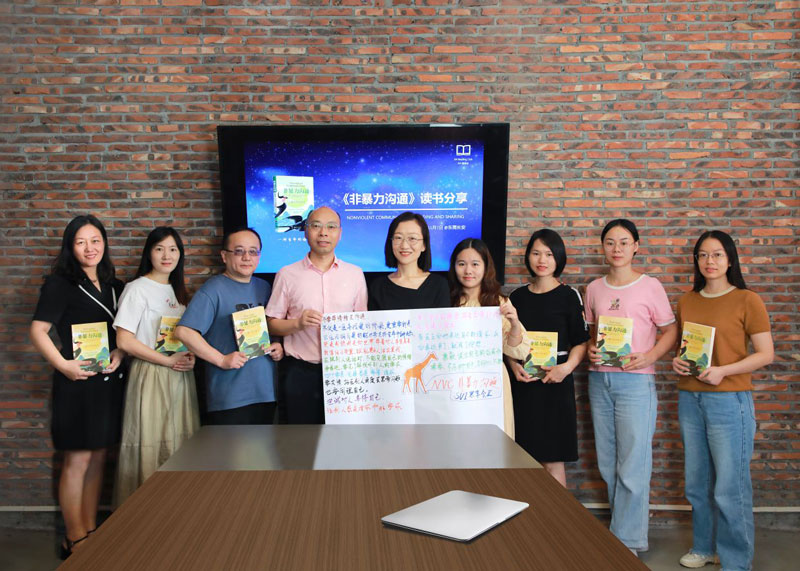What Is Vietnam Manufacturing Outlook for Businesses
- Date:
- Author: SVI Content Team
- Share:
With global trade tensions prompting businesses to diversify, many are looking beyond traditional hubs to Vietnam manufacturers for both labor-intensive and high-tech production. From electronics to textiles, made in Vietnam labels have become more and more common in the public eye. Why is Vietnam an attractive option?
In this blog, we will discuss the outlook for Vietnam manufacturing, its advantages, challenges, and why outsourcing here makes sense for businesses seeking cost-effective yet reliable production.
Part 1. What Is the Development of Vietnam Manufacturing Industry
✔ Vietnam Economic Development:
In 2024, Vietnam’s economy demonstrated robust growth, with its GDP increased by 7.09% to $476.3 billion compared to 5.05% in 2023. And imports and exports continue to maintain positive growth. Exports surged by 14.3% to US$405.53 billion, while imports grew by 16.7% to US$380.76 billion, resulting in a trade surplus of US$24.77 billion.
It’s worth noting that the United States emerged as a significant trading partner. The Vietnam goods trade surplus with the U.S. widened to US$123.5 billion, an 18.1% increase over 2023, with exports from Vietnam to the U.S. totaled US$136.6 billion, and imports from the U.S. to Vietnam totaled US$13.1 billion in 2024.
Source from the United States Census
- Vietnam’s Good Trade Surplus: the U.S. ranks second.
- U.S. Good Trade Deficit: Vietnam ranks third.
✔ Vietnam Manufacturing Development:
According to the General Statistics Office (GSO), in 2024, there were 37 commodities with exports of more than $1 billion, accounting for 94.3% of the total exports (8 goods with exports exceeding $10 billion, accounting for 69.0%).
The main export commodities are electronics, computers and components; smartphones and accessories; and machinery and equipment.
✔ Vietnam’s Foreign Investment:
- Foreign direct investment in Vietnam factories has steadily climbed. In 2024, foreign investment inflows into Vietnam rose 9.4% last year to $25.35 billion.
- Of the total exports, domestic enterprises contributed $114.59 billion, or 28.3%, while foreign-invested companies accounted for $290.94 billion, representing 71.7%.
✔ Vietnam’s Product Industry Boasts Several Strengths:
1. Skilled Craftsmanship: Vietnam is known for its skilled artisans who excel in traditional handicrafts, such as lacquerware, ceramics, candles, wooden furniture and bamboo products.
2. Diverse Materials: The country has access to a variety of locally sourced materials, enabling a wide range of unique and authentic home décor items.
3. Cultural Diversity: Vietnam’s rich cultural heritage is often reflected in its home décor, providing a unique and diverse range of products that appeal to different tastes and preferences.
4. Cost-Effective Production: Labor costs in Vietnam are generally lower than in many other countries, making it an attractive option for cost-effective production without compromising quality.
5. Growing Design Scene: Vietnam’s design community is evolving, incorporating modern aesthetics while preserving traditional craftsmanship, resulting in innovative and contemporary home décor designs.
6. Increasing Global Presence: Vietnamese home décor products are gaining popularity in international markets, indicating the industry’s competitiveness and ability to meet global demands.
Part 2. What Factors Make Vietnam A Manufacturing Destination
1. Cost-Effective Labor
Vietnam’s labor costs are lower than China’s and competitive among Southeast Asia. Based on regions, the policy of the minimum monthly wages in Vietnam shows:
- Region I: 4,960,000 VND per month (about $196 USD)
- Region II: 4,410,000 VND per month (about $173 USD)
- Region III: 3,860,000 VND per month (about $151 USD)
- Region IV: 3,450,000 VND per month (about $135 USD)
2. Strategic Geographic Location
Located in Southeast Asia, Vietnam is in proximity to China, which makes it an ideal alternative to transfer manufacturing from the major manufacturing hubs.
This situation also provides efficient access to the American market as the country is close to the Pacific Ocean. Its extensive coastline makes shipping efficient, with major ports like Tan Cang – Cat Lai, Hai Phong, and Cai Mep handling over 20 million TEUs annually.
3. Favorable Trade Agreements
Vietnam is an active member of the Association of Southeast Asian Nations (ASEAN) and has forged strong partnerships globally. It enjoys tariff-free access to over 60 economies. This gives businesses a competitive edge when leveraging Vietnam’s extensive trade network, such as:
Regional FTAs (Under ASEAN Framework)
- ASEAN Free Trade Area (AFTA)
- ASEAN-China Comprehensive Economic Cooperation Agreement (ACFTA)
- ASEAN-South Korea Comprehensive Economic Cooperation Agreement (AKFTA)
- ASEAN-India Free Trade Area (AIFTA)
- ASEAN-Japan Comprehensive Economic Partnership (AJCEP)
- ASEAN-Australia and New Zealand Free Trade Agreement (AANZFTA)
- ASEAN-Hong Kong, China Free Trade Agreement (AHKFTA)
- Regional Comprehensive Economic Partnership (RCEP)
Bilateral FTAs
- Japan-Vietnam Economic Partnership Agreement (VJEPA)
- Vietnam-Chile Free Trade Agreement (CVFTA)
- South Korea-Vietnam Free Trade Agreement (VKFTA)
- United Kingdom-Vietnam Free Trade Agreement (UKVFTA)
Multilateral Global FTAs
- Comprehensive and Progressive Agreement for Trans-Pacific Partnership (CPTPP)
- EU-Vietnam Free Trade Agreement (EVFTA)
- Eurasian Economic Union-Vietnam Free Trade Agreement (VEAEU)
4. Policies Incentives
The government has been committed to promoting the development and transformation of the manufacturing industry. By offering tax holidays, tariff reductions and support for industrial parks, it aims to attract foreign direct investment.
The country approved the Industrial Development Strategy Through 2025, with a Vision to 2035, which prioritizes sectors such as mechanical engineering, chemicals, agricultural processing, and textiles. On top of that, it is also focusing on developing high-tech and advanced products in the processing and manufacturing industries.
5. Improving Infrastructure
In recent years, Vietnam has also invested heavily in expansion and modernization. The various departments of transportation lines, roads, railways, airports, and ports have also been developed accordingly.
Its industrial development strategy for 2025-2035 also refers to the development of a new railway to run north-south, connecting Hanoi and Ho Chi Minh City, improving the capacity and safety of the route. In addition, Vietnam has pledged to build high-speed railways, build new airports and upgrade ports to increase seaports and airports’ capacity, helping to reduce lead times and cost of transporting goods.
6. Growing Focus on High-Tech Industries
Vietnam is transitioning from labor-intensive manufacturing to high-tech and value-added production. Samsung’s R&D centers and LG’s $1.5 billion Haiphong factory underscore Vietnam’s shift toward advanced manufacturing.
The government supports this shift through educational initiatives and investment in research and development (R&D) centers. By 2030, Vietnam aims to become a regional hub for electronics manufacturing and renewable energy equipment production.
Part 3. What Are the Challenges of Supply Chain in Vietnam
While Vietnam has emerged as a competitive manufacturing hub, the industry faces several significant challenges.
1. Dependence on Imported Raw Materials
In 2024, 46 goods with an import value of more than $1 billion, accounting for 93.1% of the total imports, are mainly raw materials and equipment required for industrial production. And imports like medical supplies and electronic components also increased sharply.
This reflects the fact that Vietnam’s manufacturing sector relies on imported raw materials and components, especially in textiles, electronics, and machinery production. This dependence not only increases production costs but also exposes the industry to global supply chain disruptions and fluctuating raw material prices.
According to Bloomberg, from January to November last year, 8 out of the top 10 products with the highest export growth from China to Vietnam were electronic components.
Vietnam’s imported goods in 2024 include:
- Consumer goods (6.4% of the total imports)
- Production materials (93.6% of total imports).
The production materials cover Machinery, equipment, tools, and spare parts (47.4%); and raw materials, fuels, and materials comprise (46.2%).
2. Infrastructure Bottlenecks
Despite improvements in infrastructure and policies implemented by the Vietnamese government to ameliorate the problem, the current logistics infrastructure system is still not uniform and there are many factors contributing to congestion, especially at major seaports, which cannot be ignored. This increases the transportation cost of imported and exported goods and reduces the competitiveness of Vietnamese goods in the international market. Long transit times and customs procedures, especially for export goods, remain complex and time-consuming, making it difficult for companies to get goods to market quickly.
3. Limited Industrial Sectors
Vietnam’s manufacturing industry is still dominated by labor-intensive and low-tech production, such as garment manufacturing and basic electronics assembly. The country lags in advanced manufacturing technologies like automation, robotics, and precision engineering. This limits Vietnam’s ability to move up the global value chain and attract high-tech investment.
4. Labor Skill Gaps
While Vietnam boasts a young and abundant labor force, there is a skills gap in specialized areas such as engineering, quality control, and advanced manufacturing processes. Many workers lack technical expertise and proficiency in operating complex machinery. This issue is further compounded by limited vocational training programs and insufficient collaboration between educational institutions and manufacturers.
FAQ about Manufacturing in Vietnam
Q1. Which Companies Expand Their Presence in Vietnam?
In terms of export value, Electronics, Computers and Components continued to be the largest export category. And this is due to technology companies like Samsung, LG, Apple, and Foxconn operating their manufacturing in Vietnam.
Q2. Is Vietnam a Good Manufacturing Country?
Yes. It offers competitive labor costs, strategic trade deals, and a stable economic climate, making it an increasingly popular choice for global manufacturing.
Q3. What Is Vietnam Best at Manufacturing?
Vietnam’s manufacturing products range from textiles and footwear to electronics and consumer goods. Refer to the following top 5 export value rankings for 2024 according to the source from GSO:
- Electronics, Computers & Parts – US$ 72.6 billion
- Smartphones & Parts US$ 53.9 billion
- Machinery & Equipment – US$ 52.3 billion
- Textiles – US$ 37 billion
- Footwear – US$ 22.9 billion
Q4. What Are the Industrial Zones in Vietnam?
The key industrial zones are strategically distributed across three key regions: Northern, Southern, and Central Vietnam. These zones offer ready infrastructure and tax incentives.
Northern Vietnam: Famous for electronics and high-tech manufacturing, this region is a hotspot for global giants like Samsung and Foxconn.
✅ Key Industrial Zones:
- Hanoi: Hoa Lac Hi-tech Park
- Hai Phong: Dinh Vu-Cat Hai Economic Zone
- Hai Duong: An Phat High-Tech Industrial Park
- Bac Ninh: Yen Phong II Industrial Park, Vietnam Singapore Industrial Park
- Nam Dinh: Bao Minh Industrial Park
Southern Vietnam: Known as Vietnam’s manufacturing hub, this region is ideal for textiles, furniture, and consumer goods production.
✅ Key Industrial Zones:
- Ho Chi Minh City: Hiep Phuoc Industrial Park, Saigon Hi-Tech Park—SHTP, Tan Tao Industrial Park
- Dong Nai: Amata Industrial Park
- Binh Duong: Vietnam Singapore Industrial Park (VSIP)
- Long An: Prodezi Eco-Industrial Park
- Ba Ria-Vung Tau: Phu My 2 Industrial Park
Central Vietnam: Emerging as a new manufacturing destination, especially for heavy industry and logistics.
✅ Key Industrial Zones:
- Da Nang: Da Nang Hi-tech Park, Lien Chieu Industrial Park
- Thua Thien-Hue: Phong Dien Industrial Park, Sai Gon–Chan May Industrial Park and Non-tariff zone
- Quang Nam: Dien Nam – Dien Ngoc Industrial Park
- Binh Dinh: Nhon Hoi Industrial Park, Becamex VSIP Binh Dinh
Q5. Is Made in Vietnam Good Quality?
Quality varies by supplier. The goods made in Vietnam definitely meet international standards, especially in electronics and apparel. If you want to make sure your products sourced from Vietnam are secured, implementing thorough audits and reliable quality control inspections can further ensure high-quality outcomes.
At SVI Global, we go beyond sourcing—we ensure quality at every stage. Our comprehensive quality assurance services include factory audits, product and packaging testing, sample evaluations, TOP inspections, in-line inspections and final inspections. Need support in tackling quality issues? Let us help you secure products to meet the highest international standards.
Q6. Is Vietnam Better than China for Manufacturing?
China often offers competitive production costs due to economies of scale and a well-established manufacturing infrastructure, while Vietnam is known for skilled craftsmanship, particularly in handmade products, while China has a vast manufacturing infrastructure.
Consider factors like cost, quality, and design preferences when choosing between Vietnam vs China for product sourcing.
Conclusion
The Vietnam manufacturing industry stands out for its cost-effective labor, strategic location, favorable trade agreements, and government incentives, making it an attractive destination for manufacturing. Meanwhile, you will need to have an all-sided perspective on the challenges of the sector, such as reliance on imported raw materials, infrastructure limitations, and labor skill gaps. It is an undeniable fact that manufacturing in Vietnam is growing and the government is making an effort for the development.
If you intend to step out of your “comfort zone” and take a chance to diversify your sourcing strategy and explore suppliers in Vietnam, SVI Global will certainly be your right-hand man. We focus on global market shifts and have proactively established our team in Vietnam, which enables us to deliver the best sourcing solutions and help you source high-quality products at the most competitive prices.








